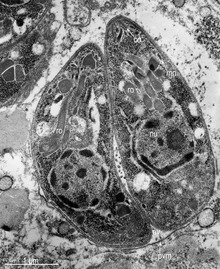

|
m Open access bot: pmc updated in citation with #oabot.
|
→Facultative: Add Mycobacterium tuberculosis
|
||
| Line 11: | Line 11: | ||
Bacterial examples include: |
Bacterial examples include: |
||
* ''[[Bartonella henselae]]''<ref>{{cite web|url=http://www.vetmed.auburn.edu/wp-content/uploads/2015/03/Bartonella-henselae.pdf|title=Bartonella henselae}}</ref> |
* ''[[Bartonella henselae]]''<ref name=":2">{{cite web|url=http://www.vetmed.auburn.edu/wp-content/uploads/2015/03/Bartonella-henselae.pdf|title=Bartonella henselae}}</ref> |
||
* ''[[Francisella tularensis]]'' |
* ''[[Francisella tularensis]]'' |
||
* ''[[Listeria monocytogenes]]''<ref>{{Cite journal|last1=Dramsi|first1=Shaynoor|last2=Cossart|first2=Pascale|date=2002-03-18|title=Listeriolysin O|journal=The Journal of Cell Biology|volume=156|issue=6|pages=943–946|doi=10.1083/jcb.200202121|issn=0021-9525|pmc=2173465|pmid=11901162}}</ref> |
* ''[[Listeria monocytogenes]]''<ref>{{Cite journal|last1=Dramsi|first1=Shaynoor|last2=Cossart|first2=Pascale|date=2002-03-18|title=Listeriolysin O|journal=The Journal of Cell Biology|volume=156|issue=6|pages=943–946|doi=10.1083/jcb.200202121|issn=0021-9525|pmc=2173465|pmid=11901162}}</ref> |
||
| Line 23: | Line 23: | ||
* ''[[Yersinia]]'' |
* ''[[Yersinia]]'' |
||
* ''[[Staphylococcus aureus]]''<ref>{{Cite journal | last = Bravo-Santano | title = Intracellular Staphylococcus aureus Modulates Host Central Carbon Metabolism To Activate Autophagy | journal = American Society for Microbiology | year = 2018 | doi=10.1128/mSphere.00374-18 | display-authors = etal| doi-access = free | volume = 3 | issue = 4 | pages = e00374–18 | pmid = 30089650 | pmc = 6083095 }}</ref> |
* ''[[Staphylococcus aureus]]''<ref>{{Cite journal | last = Bravo-Santano | title = Intracellular Staphylococcus aureus Modulates Host Central Carbon Metabolism To Activate Autophagy | journal = American Society for Microbiology | year = 2018 | doi=10.1128/mSphere.00374-18 | display-authors = etal| doi-access = free | volume = 3 | issue = 4 | pages = e00374–18 | pmid = 30089650 | pmc = 6083095 }}</ref> |
||
* ''[[Mycobacterium tuberculosis]]'' (within the macrophages)<ref name=":2" /> |
|||
Fungal examples include: |
Fungal examples include: |
||
Intracellular parasites are microparasites that are capable of growing and reproducing inside the cells of a host.[citation needed]
There are two main types of intracellular parasites: Facultative and Obligate.[1]
Facultative intracellular parasites are capable of living and reproducing in or outside of host cells. Obligate intracellular parasites, on the other hand, need a host cell to live and reproduce. Many of these types of cells require specialized host types, and invasion of host cells occurs in different ways.[1]
Facultative intracellular parasites are capable of living and reproducing either inside or outside cells.
Bacterial examples include:
Fungal examples include:

Obligate intracellular parasites cannot reproduce outside their host cell, meaning that the parasite's reproduction is entirely reliant on intracellular resources.
Obligate intracellular parasites of humans include:
The mitochondria in eukaryotic cells may also have originally been such parasites, but ended up forming a mutualistic relationship (endosymbiotic theory).[14]
Study of obligate pathogens is difficult because they cannot usually be reproduced outside the host. However, in 2009 scientists reported a technique allowing the Q-fever pathogen Coxiella burnetii to grow in an axenic culture and suggested the technique may be useful for study of other pathogens.[15]
Polypodium is a metazoan intracellular parasite, distinct from most if not all other intracellular parasites for this reason.[citation needed]
When an intracellular parasite goes to enter a host cell, it is particular about the type of host cell. This is because most intracellular parasites are able to infect only a few different cell types.[16] The entrance of these host cells will differ between intracellular parasites. Not all intracellular parasites will enter a cell the same way. Some will work with specific components in or on the host cell, an example being Trypanosoma cruzi. This parasite will attach itself to the host cell while increasing the intracellular calcium, which in turn disrupts the actin at the site of attachment, causing the host cell to create a lysosomal-barrier around the disruption. The parasite will take advantage of this membrane and produce a vacuole in the host cell. Other intracellular parasites have developed different ways to enter a host cell that do not require a specific component or action from within the host cell. An example is intracellular parasites using a method called gliding motility. This is the use of an actin-myosin motor that is connected to the intracellular parasites' cytoskeleton.[16]
The majority of intracellular parasites must keep host cells alive as long as possible while they are reproducing and growing. In order to grow, they need nutrients that might be scarce in their free form in the cell. To study the mechanism that intracellular parasites use to obtain nutrients, Legionella pneumophila, a facultative intracellular parasite, has been used as a model. It is known that Legionella pneumophila obtains nutrients by promoting host proteasomal degradation. Self-degradation of host proteins into amino acids provides the parasite with its primary carbon and energy source.[17]
People with T cell deficiencies are particularly susceptible to intracellular pathogens.[18]